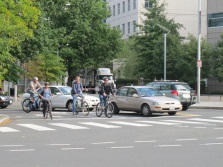Designing for Bikes

Bicycle transportation planning, like other transportation planning, is concerned with travel demand, safety, convenience, and economics. Its premise is that all roads are bikeways (except limited access highways), but the kind of facility will vary depending on the street type, use, and conditions.
Effective bikeway networks require rededicating some existing roadway space to bicycle-specific facilities and/or ensuring that speeds are low enough to allow all modes to coexist.
Bicycle Facilities
Bicycle facilities are considered at the inception of all Cambridge transportation projects and become incorporated into the design of each project. City departments coordinate their work to ensure that all construction is reviewed in the design phase of every project to address the needs of bicycle transportation. Often these improvements can be made at a low cost, benefiting cyclists, motorists, and pedestrians alike.
There are several ways to improve streets for cyclists, and designs for how streets are retrofit will be done on a case-by-case basis. Marked bicycle facilities are usually the appropriate choice for wider and/or busier streets. Some streets – usually residential streets – will benefit from traffic calming measures, which also can enhance the traveling environment for bicyclists, as speeds will be low and cyclists can more comfortably share the road with motorists.
On this website are descriptions of some of the bicycle facilities that are being implemented in order to achieve the goals of supporting and encouraging bicycling. Click in the boxes below to learn more about some bicycle facilities commonly seen on Cambridge streets.
Click Here for a Planning Map of Bicycle Facilities in Cambridge. Please note that this map is for planning purposes and is not a route map.
Additional References and Resources
For more information on bicycle facility planning and design:
For More Information
For more information about bicycling in Cambridge, please contact cddat344@cambridgema.gov.